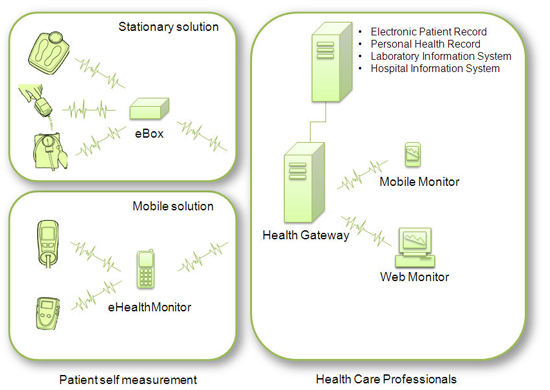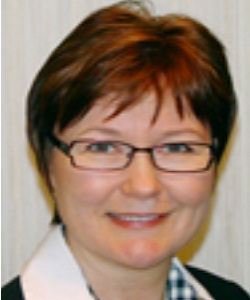Finland is a Nordic country with a population of 5.3 million inhabitants. The country is famous for a good system for healthcare and social welfare, which is based on extensive public responsibility and tax funding1. The vision for 2015 Ministry of Social Affairs and Health view that information and communication technology can enable the efficient management of client information and process management using real-time data.2 Information technology provides the best support for a productive health service system when compatible joint standards and applications are used nationwide.
Finland is a Nordic country with a population of 5.3 million inhabitants. The country is famous for a good system for healthcare and social welfare, which is based on extensive public responsibility and tax funding1. The vision for 2015 Ministry of Social Affairs and Health view that information and communication technology can enable the efficient management of client information and process management using real-time data.2 Information technology provides the best support for a productive health service system when compatible joint standards and applications are used nationwide.
Because of vast distances and a sparse population, Finland has been one of the forerunners in developing telemedicine and eHealth services in the world. In Finland, eHealth was developed in three steps: on a local, regional and national scale. The first step saw a change from paper to electronic documentation. The second step, development on a regional level meant a change to electronic data exchange between primary and secondary health service providers, which necessitates the use of highly secure networks. In the course of third step, the national development, today’s hierarchy will be replaced by a seamless flow of patient data between health care providers and citizens and service providers. 3 In addition, wireless technology has been a special focus area.
Basic ICT infrastructure is good in Finland. According to Statistic Finland (2007) 98 % of Finnish households have a mobile phone, 75 % home PC, 70 % internet connection, 62 % broad band, and 78 % digital TV4. Citizens are willing to use ICT in health services. In addition, ICT skills of the health care personnel are good. 90-100 % of the personnel reading or documenting patient data has basic computer skills5
Electronic Health Record as a platform for eHealth services
In Finland, electronic patient record (EPR) is widely used. In the end of year 2007 close to 100 % of all the municipal primary health care units and all hospital district care units were using electronic health care records6. Today paper-based records serve only as an archive for historical data. In order to assure the interoperability of EPR, the national standards for contents of core data, national technical standards, principles for data security and privacy, EPR messaging and archiving based on HL7, CDA and XML, national directory services for health care providers have been set. Finland is currently implementing national healthcare IT architecture. IT systems are backed up by legislation and will become mandatory for all healthcare providers by March 20117. The national architecture consists of 1) local EPRs using common data structure and technical standard, 2) national eArchive, 3) national ePrescription database, and 4) eView for citizens .
Electronic health record forms a good platform for different kinds of electronic health services and applications. Those can build a network suitable for health services in hospitals, primary health care units and citizen’s homes. Direct citizen centred services are emerging, such as web-appointments, own health card and messaging services between professionals and citizens8.
Present trend – Empowerment of citizens to self-care
In industrialized countries the forecasting facts are that the population is ageing, there is the increasing need for reliable health information for the citizens, the growing need for health care services, the growing need for financial resources, the need for activating the citizens’ role in the health care processes and increasing and making possible the self responsibility of citizens for their own health and welfare and finally the need for information management.9
In the City of Oulu, Finland, a vast project on Citizen’s Self Care has been started9. With the joint funding of City of Oulu, Finnish Funding Agency of Technology and Innovation and Ministry of Social Affairs and Health, the Oulu Self Care project has been launched for years 2004-2009. Collaboration of local government (City of Oulu) and several enterprises (Coronaria Ltd., Mawell Ltd., Prowellness Ltd., Duodecim Publishing Ltd., eHIT Ltd.) will serve for developing new ways of providing eHealth services.
During the project it has been build up a new service concept using latest web technologies, which offers the citizens a self controlled way to respond their own health and diseases (Fig. 1. and 2) . In addition to those it enables an electronic reciprocal action with health care services for example following:
- A web portal that stores general information concerning health-related issues and services
- The exchange of laboratory results to patients
- Transfer of home-made point-of-care measurements of vital data from patient to professionals
- Question & answer services for the public
- Development and maintenance of personal health records.
This concept has been developed and made for citizens of all ages and also for those who are responsible of the care of the elderly. Desired outcome is national service model, which could be adopted also in other cities.
Fig.1. Oulu Self Care Service platform10 (Mawell Ltd.)
The seamless and real-time patient-doctor communications with the patient’s medical record and nursing support is integrated by eHIT Ltd’s Health Gateway11. This eHealth solution provides an effective and secure tool for transferring data from different measurement devices to the health care professionals via both a mobile platform and wireless GSM/GPRS/3G networks (Fig. 2). The information received can be either stored in the Health Gateway server or directly forwarded to existing information systems. In this way the accuracy of the measurement data is always maintained and the data are available to the health care professionals in real-time and in the appropriate format. Timely review of patient data with close to real-time feedback improves compliance and makes treatment faster, easier and cost effective.

Fig. 2 Transfer of home-made point-of-care measurements of vital data from patient to professionals (eHIT Ltd.)
Hospitals go wireless
Wireless technology provides unique and novel ways to optimize and enhance hospital processes. Wirelessness creates new opportunities for hospitals to operate flexibly in the different phases and subprocesses of their processes. The University Hospital of Oulu (Northern Ostrobothnia Hospital District, Finland) has conceived a concept of a wireless hospital to be tested and produced with regards to an international business concept. At the core of the ’Wilho’-concept is the WHAN® − Wireless Hospital Area Network with open interfaces both to/from the HIS − Hospital Information System and to/from the various applications in hospital processes. In tracking and data transmission, either WLAN or UWB technology (Ultra Wide Band) is used depending on the application and its requirements. A wireless network in a hospital enables the early continual monitoring of patient transfers without disruptive wires. Wireless networks make data available in real time in follow-up care locations as soon as the patient arrives. Wireless networks and applications also enable the continuous, unbroken monitoring of a patient’s condition. Wireless terminal devices provide doctors and nursing staff with the ability to access patient data anywhere within the coverage area of the wireless network. When a network user makes changes to patient data, all users of the network can see the new updated data immediately. Using his or her palmtop computer, a doctor can prescribe medication or update changes to a patient’s condition and the information is immediately available to the entire nursing staff 12. The future vision is that wireless technology will become a permanent part of the data networks, data systems and logistics of hospitals. It significantly improves the quality of diagnostics as well as personal data and process information
Conclusions
In Finland the basic infrastructure for eHealth services is ready. Health centers and hospitals have developed medical ICTs accordingly, and the personnel has basic skills for those. Majority of citizens, including older adults, are willing to use eHealth services. The good collaboration between academy, industry and government to support research and development of emerging web technologies and eHealth applications form a good base for further eHealth implementations
References:
- Salo S. Health and Welfare in Finland. Journal of Japan Medical Society 2007; March: 20-27.
- Tietoyhteiskuntaohjelma, Valtioneuvoston kanslia. A renewing, human-centric and competitive Finland, A National Knowledge Society Strategy 2007 – 2015. Strategia_englanti_final.pdf
- Winblad I., Hämäläinen P., Reponen J. Targeting Finnish e-health. Hospital Information Technology 2008; 1: 41-43
- http://www.tilastokeskus.fi/til/tvie/tau.html
- Hämäläinen P., Reponen J., Winblad I. eHealth of Finland. Checkpoint 2006. National Research and Development Centre for Health Report 1/2007. STAKES 2007: 41-42
- Hämäläinen P., Reponen J., Winblad I. eHealth of Finland. Checkpoint 2008. National Research and Development Centre for Health Report. STAKES 2008 (in press)
- Act 2007/159. Laki sosiaali- ja terveydenhuollon asiakastietojen sähköisestä käsittelystä (in Finnish, content in English: legistlation on eArchiving)
- Hämäläinen P., Reponen J., Winblad I.,eHealth of Finland. Checkpoint 2006. National Research and Development Centre for Health Report 1/2007. STAKES 2007: 39-40
- Salo S., Koski K. eHealth and self-care concepts in Finland – Case Oulu. Japanese Journal of Telemedicine and Telecare 2008; 4: 180-182

















